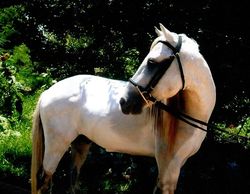|
|
|
The Spanish Mustang: History
The Spanish Mustang also known as the Colonial Spanish Horse is of great historic importance and one of the few remaining genetically unique horse breeds worldwide. They have both local and global importance for genetic conservation. They are sensible, capable mounts that have for too long been given a very peripheral role in North American horse breeding and sporting. The combination of great beauty, athletic ability, and genetic importance makes this breed a very significant part of history. They descend from horses introduced from Spain during the early conquest of the Americas, breeds that today are now mostly extinct, and it is believed that they arrived on Columbus's second voyage to the new world. Among these descendents are the: Spanish Jennet, Spanish Barb, and Sorraia, the Spanish Mustangs also has modern day connections to breeds such as the: Andalusian, Lusitano, and Paso. Owning a Spanish Mustang is truly like possessing your own piece of the 16th century, yet their capabilities have been vastly undervalued for most of the 1900s. These are beautiful and capable horses from a genetic pool that affected horse breeding throughout the world five centuries ago. The Colonial Spanish Horse: the term that is used to describe these horses in North America is Spanish Mustang, but the term “mustang” carries with it the unfortunate connection to any feral horse, so this title serves poorly in several regards. Many Colonial Spanish Horses or Spanish Mustangs have never had a feral background, but are instead the result of centuries of careful breeding. In fact, only a very small minority of feral horses (Mustangs/BLMs) in North America qualify as being Spanish in type and breeding. The important part of the background of the Spanish Mustang is that they are indeed Spanish; a true Iberian horse that should be recognized as such, but for now is not. In the late 19th and early 20th century, many attempted to introduced Throughbreds, Arabians, and Morgans to the Spanish Mustang, seeking to “improve the breed”. On the brink of extinction the salvation of the Spanish Mustang can be attributed primarily, but not exclusively, to Ferdinand L. Brislawn and Robert E. Brislawn of Oshoto, Wyoming, who later founded the Spanish Mustang Registry, Inc. in 1957. The Spanish Mustang: Confirmation The Spanish Mustang Registry, Inc. describes the breed standard as follows:
"The Spanish Mustang is a medium sized horse ranging from 13.1 to 15 hands with an average size of approximately 14.2 hands with proportional weight. They are smooth muscled with short backs, rounded rumps and low set tails. Coupling is smooth and the overall appearance is of a well balanced, smoothly built horse. The girth is deep, with well laid back shoulder and fairly pronounced withers. They possess the classic Spanish type head with a straight or concave forehead and a convex nose which is in contrast to the straight forehead and nose of most breeds. Ears are medium to short and usually notched or curved towards each other. Necks are fairly well crested in mares and geldings and heavily crested in mature stallions. Chests are narrow but deep with the front legs joining the chest in an "A" shape rather than straight across. Chestnuts are small or missing altogether, particularly on the rear legs. Ergots are small or absent. Feet are extremely sound with thick walls, many having what is typically known as a "mule foot" which resists bruising due to the concave sole. Cannons are short, upper foreleg is long with the canon bone having a larger circumference than other breeds of comparable size and weight. Long strided, many are gaited, with a comfortable gait such as the amble, running walk or single foot. Some individuals are laterally gaited and do a very credible "Paso" gait though without extreme knee action. They are remarkably hardy animals and tend to be less prone to injury, particularly of the legs and feet, than other breeds.” Interested in learning more indepth information about the Spanish Mustang?
Read the Sponenberg Reports wrriten by D. Phillip Sponenberg, DVM, PhD.
|
|
|
FWP's Carena "Honey"
|
|
|
FWP's Playboy "Chico"
|
 |
FWP's Grey's Oreo "Ro"
|
|
|


